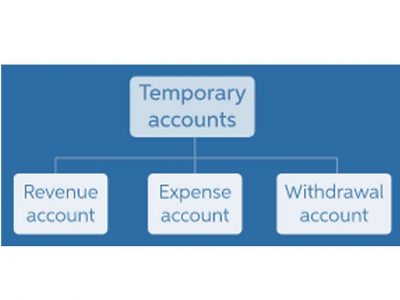
Every valid business transaction financially impacts the entity’s financial position. This impact refers to the increase or decrease in the accounts identified in the first step. Owners’ equity, also known as stockholders’ equity or shareholder’s equity, is the value the company’s owners have in their claim to the company’s assets. The partnership divides the owner equity among its members, allocating each member’s share to an individual account. The final step involved in transaction analysis is to apply the rules of debit and credit on accounts. The fundamental concepts above will enable you to construct an income statement, balance sheet, and cash flow statement, which are the most important steps in the accounting cycle.
Financial Accounting

A simplified account, called a T-account, is often used as a teaching or learning tool to show increases and decreases in an account. It is called a T-account because it resembles the letter T. As shown in the T-account below, the left side records debit entries and the right side records credit entries.
Transactions that Affect the Income Statement

All of our content is based on objective analysis, and the opinions are our own.
Step 2 of 3
Monthlypayments of $532 were due at the beginning of each month, startingon September 1 (see Exhibit 2). She was also required to take outinsurance on the car, with payments of $540 per quarter due inadvance every three months, starting on September 1. The tutors andChang coordinated the schedules so that the car would be availablefor tutoring visits. They drove quite a few miles and used anaverage of $100 per month in gas, starting in September. Sales and income taxes are the most common typeof derived taxes, meaning the taxes collected are derived from someother transaction. For derived taxes, the revenues becomemeasurable and available when the underlying transaction takesplace.
What is the approximate value of your cash savings and other investments?
For ease of reference additional examples of double entry bookkeeping transactions can be found in our examples section. According to GAAP, OP should recognize the assetsfrom derived revenues during the period when the underlyingtransaction takes place. That’s why it records all $20 million assales taxes receivable. At the same time, it will only collect $12million within 60 days of the end of the fiscal year, so only thatportion is considered available and should be recognized now.

- This chapter tries to answer to five questions, as basis for the accounting process.
- That said, thisframework does cover certain types of transactions, and sometimesdifferent types of non-profit and governmental transactions haveunique rules that apply just in those contexts.
- For instance, imagine if Treehouse had purchased theaudiology equipment with cash rather than on credit.
- This transaction adds to both sidesof the fundamental equation, and the net effect on the equation iszero.
- Bold City Consulting borrows $2,500 cash from the bank and signs a two-year note payable to the bank.
- T-accounts are a visual representation tool used to analyze and record transactions in accounting.
Step 5 Record the entry and post to the accounts in the general ledger. Double Entry Bookkeeping is here to provide you with free online information to help you learn and understand bookkeeping and introductory accounting. Chartered accountant Michael Brown is the founder and CEO of Double Entry Bookkeeping. He has worked as an accountant and consultant for more than 25 years and has built financial models for all types of industries. He has been the CFO or controller of both small and medium sized companies and has run small businesses of his own. He has been a manager and an auditor with Deloitte, a big 4 accountancy firm, and holds a degree from Loughborough University.
This is because the capital account is credited when capital increases. In the above example, the two accounts involved are the cash account and capital account, both of which are increasing. Every business transaction involves two or more accounts. The process of analyzing a business transaction starts with identifying these accounts. In November, a local newspaper ran a story aboutPASS’s efforts which attracted the interest of a localentrepreneur, Charles Duncan.
- In a perfect world, non-profitmanagers would fund all their operations through unrestrictedprogram revenues and donations.
- For this reason, when thinking about the fundfinancial statements, we need to re-think how we recognize certainrevenues.
- Your information is kept secure and not shared unless you specify.
- It will also record – or recognize,in accounting speak – an account payable for $20,000.
- To fully understand the accounting cycle, it’s important to have a solid understanding of the basic accounting principles.
- Step 1 The business received equipment in exchange for cash paid to the equipment manufacturing company.
- At the outset, it might seem like the accrualconcept breaks down here.
Additional Resources
- Unrealized gains and losses do not directlyaffect cash or any other resources that Treehouse has available todeliver services.
- If a government agrees to pay a legalsettlement, it will recognize an expenditure only if thatsettlement is paid out of current financial resources.
- On the cash basis it will be several weeks beforewe know those expenses had been incurred and that Treehouse hadearned $2,500 in revenue.
- Donors whosupport a non-profit are, in effect, paying that non-profit topursue its mission.
When an organization sells a good, it presumably knowswhat it cost to produce that good. Those costs, known generally ascost of goods sold, are immediately netted against therevenue collected from the transaction. That’s why in the flowchart above you see some additional recognition related todelivering goods. GAAP (specifically, FASB Statement 157)classifies investments by a three-level scheme according toavailability of market prices. This includes stocks and moneymarket funds, among others. Level 2 assets are primarilysold “over-the-counter,” like corporate bonds, futures contracts,stock options, and others.

How confident are you in your long term financial plan?
For sales taxes, those transactions are taxable retailsales. There the“transaction” in question is when an employer pays wages to anemployee, and that transaction denotes the earnings on which theincome tax is based. Transaction 10 does not affect theincome statement, but keep in mind that the transaction thatresulted in the original accounts receivable did. This system is popular because it’s fast, easy topresent, and appeals to our desire for symmetry.
Which ledger accounts does the transaction affect?
The balance sheet would experience an increase in assets and an increase in liabilities. Step 1 The business received transaction analysis accounting cash in exchange for consulting services. The accounts involved in the transaction are Cash and Service Revenue.

